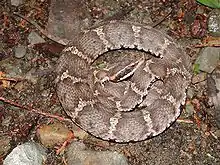Gloydius
Gloydius is a genus of venomous pitvipers endemic to Asia, also known as Asian moccasins or Asian ground pit vipers. Named after American herpetologist Howard K. Gloyd,[2] this genus is very similar to the North American genus Agkistrodon. 22 species are currently recognized.[3]
| Gloydius | |
|---|---|
 | |
| Gloydius blomhoffii, Japanese mamushi | |
| Scientific classification | |
| Kingdom: | Animalia |
| Phylum: | Chordata |
| Class: | Reptilia |
| Order: | Squamata |
| Suborder: | Serpentes |
| Family: | Viperidae |
| Subfamily: | Crotalinae |
| Genus: | Gloydius Hoge & Romano-Hoge, 1981 |
| Synonyms[1] | |
| |
Geographic range
Species of Gloydius are found in Russia, east of the Ural Mountains through Siberia, Iran, Himalayas from Pakistan, India, Nepal, China, Korea, Japan and the Ryukyu Islands.[1]
Species
| Species[3] | Taxon author[3] | Subsp.*[3] | Common name[4] | Geographic range[1] |
|---|---|---|---|---|
| G. angusticeps | Shi, Yang, Huang Orlov, & Li, 2018 | 0 | Zoige pit viper | China, (Sichuan, Qinghai, and Gansu). |
| G. blomhoffii | (Stejneger, 1907) | 3 | Japanese mamushi | China, Korea and Japan. |
| G. brevicaudus | (H. Boie, 1826) | 0 | Short-tailed mamushi | North Korea, South Korea, and China. |
| G. caraganus | (Eichwald, 1831) | 0 | Karaganda pitviper | Uzbekistan, Turkmenistan, Tajikistan, Kyrgyzstan, and Kazakhstan. |
| G. caucasicus | (Nikolsky, 1916) | 0 | Caucasian pitviper | Turkmenistan, Azerbaijan, Iran, and Afghanistan. |
| G. cognatus | (Gloyd, 1977) | 0 | Alashan pitviper | China. |
| G. halysT | (Pallas, 1776) | 4 | Siberian pitviper | Russia, east of the Ural Mountains through Siberia, Iran, Mongolia to northern and central China, as well as the southern Ryukyu Islands. |
| G. himalayanus | (Günther, 1864) | 0 | Himalayan pitviper | Along the southern slopes of the Himalayas from northeastern Pakistan, to northern India (Kashmir, Punjab) and Nepal. Found at 1524–3048 m altitude. |
| G. huangi | Wang, Ren, Dong, Jiang, Shi, Siler, & Che, 2019 | 0 | Lancang Plateau viper | Tibet. |
| G. intermedius | (Strauch, 1868) | 2 | Central Asian pitviper | Southeastern Azerbaijan, northern Iran, southern Turkmenistan, northwestern Afghanistan, southern Russia, northwestern China and Mongolia. |
| G. lijianlii | Jiang & Zhao, 2009 | 0 | North coast Shandong peninsula in China. | |
| G. liupanensis | Liu, Song, & Luo, 1989 | 0 | Gansu, China. | |
| G. monticola | (F. Werner, 1922) | 0 | Likiang pitviper | The mountains of northern Yunnan in China. |
| G. qinlingensis | Song & Chen, 1985 | 0 | Shaanxi, China. | |
| G. rickmersi | Wagner, Tiutenko, Borkin, & Simonov, 2015 | Kyrgyzstan | ||
| G. rubromaculatus | Shi, Wang, Chen, Fang, Ding, Huang, Hou, Liu, & Li, 2017 | 0 | Tibetan Plateau. | |
| G. saxatilis | (Emelianov, 1937) | 0 | Rock mamushi[5] | Russia (eastern Siberia), northeastern China and North and South Korea. |
| G. shedaoensis | (Zhao, 1979) | 0 | Shedao island pitviper | Shedao Island, off the coast of Liaotung, China. |
| G. stejnegeri | (Rendahl, 1933) | 0 | Gobi pitviper | China and Mongolia. |
| G. strauchi | (Bedriaga, 1912) | 0 | Strauch's pitviper | The Tibetan Plateau in the provinces of Tsinghai and western Szechwan, China. |
| G. tsushimaensis | (Isogawa, Moriya & Mitsui, 1994) | 0 | Tsushima Island pitviper | Tsushima Island, Japan. |
| G. ussuriensis | (Emelianov, 1929) | 0 | Ussuri mamushi | Far east Russia (Primorskiy Kray), northeastern China, North and South Korea, as well as Quelpart Island. |
*) Not including the nominate subspecies.
T) Type species.
Taxonomy
Due to the strong morphological similarity, these snakes were classified in the genus Agkistrodon until very recently. However, by 1999 cladistic studies clearly showed that Agkistrodon did not form a clade (indeed, it was not even paraphyletic) and was thus split into several genera.
A new species, G. tsushimaensis, was described by Isogawa, Moriya & Mitsui (1994). It is referred to as the Tsushima island pitviper and is found only on Tsushima Island, Japan.
References
- McDiarmid RW, Campbell JA, Touré TA (1999). Snake Species of the World: A Taxonomic and Geographic Reference, Volume 1. Washington, District of Columbia: Herpetologists' League. 511 pp. ISBN 1-893777-00-6 (series). ISBN 1-893777-01-4 (volume).
- Beolens, Bo; Watkins, Michael; Grayson, Michael (2011). The Eponym Dictionary of Reptiles. Baltimore: Johns Hopkins University Press. xiii + 296 pp. ISBN 978-1-4214-0135-5. (Gloydius, p. 102).
- "Gloydius ". Integrated Taxonomic Information System. Retrieved 17 October 2006.
- Gumprecht A, Tillack F, Orlov NL, Captain A, Ryabov S (2004). Asian Pitvipers. First Edition. Berlin: Geitje Books. 368 pp. ISBN 3-937975-00-4.
- Gloyd HK, Conant R (1990). Snakes of the Agkistrodon Complex: A Monographic Review. Society for the Study of Amphibians and Reptiles. 614 pp., 52 plates. LCCN 89-50342. ISBN 0-916984-20-6.
Further reading
- Hoge AR, Romano-Hoge SA (1981). "Poisonous Snakes of the World. I. Checklist of the Pitvipers: Viperoidea, Viperidae, Crotalinae". Memórias do Instituto Butantan 42/43: 179-309. (Gloydius, new genus).
- Isogawa, Kiyoshi; Moriya, Akira; Mitsui, Sadaaki (1994). "A new snake from the genus Agkistrodon (Serpentes: Viperidae) from Tsushima Island, Nagasaki Prefecture". Japanese J. Herpetol. 15: 101-111. (Agkistrodon tsushimaensis, new species).
External links
| Wikimedia Commons has media related to Gloydius. |
- Gloydius at the Reptarium.cz Reptile Database. Accessed 12 December 2007.
- Taxonomy comparison by Dr. Wolfgang Wüster at Dr. Brian Grieg Fry's Int'l Venom & Toxin Database. Accessed 25 July 2007.